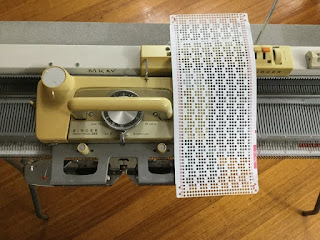I want any new knitter to consider the proposition that you can knit a wide variety of weights, stitch patterns and knitted items with just one standard gauge punchcard machine. Now if your hobby is machines, rather than knitting, by all means collect every domestic machine and accessory ever produced. Its an interesting study and a potential lifetime hobby, but not much help for a newcomer hoping to make interesting and useful items, with limited hands on support.
“What kind of yarn do you want to knit?” This is the question often put instead of an answer to the question, “I’d like to take up machine knitting, what machine should I get?”
The friendly local knitting machine dealer, only too happy to sell you three gauges of machine, a garter carriage and every conceivable accessory, and to employ an expert to provide ongoing instruction in the use of all these, is an extinct species of business operator.
In my part of the world there are still old, more or less indestructible, standard gauge punchcard machines machines to be found. Even the top of the price range of second hand machines of this sort represents amazing creative value for money, and Op shop bargains still turn up. Even the brand new equivalents, still made by the Silver Reed company, are great creative value.
On a standard gauge machine you can knit a wide range of
Weights of Fabric. You do not need to use light, medium or bulky yarns to make light, medium or bulky fabrics. In any case, the range of weights of yarn that can knitted on a standard gauge machine is rather wider than generally recognised.
One machine - one card - one stitch setting
Singer 329 - Card4 - Tuck setting
A textured knit, pleasing to look at from either side of the fabric
Denise Chevalier’s Let’s Twist Again,
As featured in the the Parade at the 2016 Australian Sheep and Wool Show in Bendigo.
Denise Chevalier again in a previous version of the same design knitted in stocking stitch on the same Singer 360 machine.





























